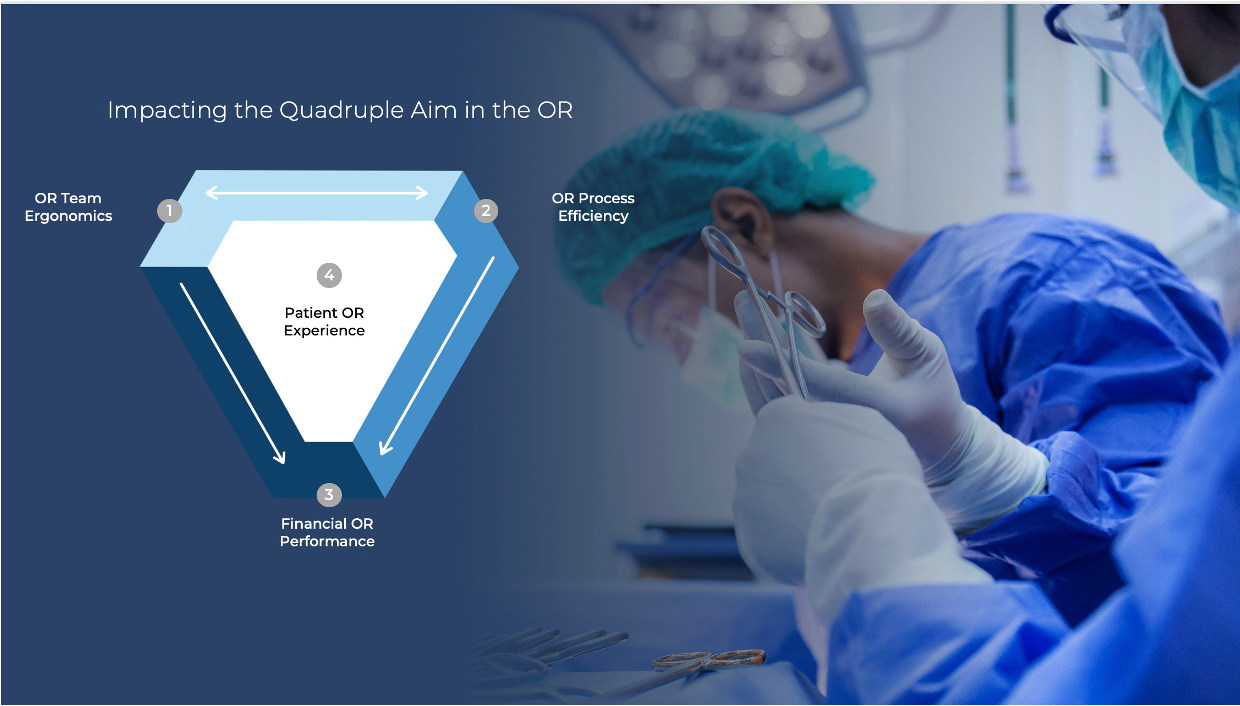Process digital twin for the OR
The quest to increase operating room (OR) efficiency is never-ending, as gathering and analyzing data can be a complex and costly process. The introduction of process digital twin technology is poised to expedite advancements (1) in healthcare settings, including in hospitals, clinics, and ambulatory surgery centers (ASCs). This promising artificial intelligence (AI) offers new ways to harness data to increase process efficiency, team ergonomics, patient experience, and financial performance in the operating room, ultimately supporting the quadruple aim (2).
The current adoption of digital twins in healthcare is still in its infancy. However, less than a year ago, two-thirds of healthcare professionals (3) reported they expected “increasing investments in digital twins, the adoption of which helps to improve the performance of healthcare organizations, facilitate personalization of medicine, provide customizations, and enable the development of new devices and medications.” And recent research shows that the global (digital twin in healthcare) market is expected to rise more than 25 percent annually through 2030 ($572.4 million USD in 2020 to $3.5 billion USD in 2030) (4)
Process Digital Twins in Healthcare
While digital twins were initially introduced in healthcare (5) to recreate physical products, they have risen in popularity (6) because healthcare leaders saw the opportunity to increase operational excellence; thereby, reducing costs without compromising the quality of care in healthcare facilities worldwide.
Of note, research (7) shows that using digital twins to improve healthcare processes and systems is on the rise. Their market value and annual growth rate (28.7%) (8) are expected to surpass that of product digital twins, with factors like the use of artificial intelligence and virtual reality contributing to process digital twin market growth.
Even though most process digital twins are available at the hospital management level, DEO.care uses this form of AI for operating rooms because of opportunities for cost reductions (9); the OR is the largest hospital cost category.
A process digital twin enables hospitals to analyze the workflow and process involving multiple team members and tools in the operating room to better understand shortcomings and glean insights on areas for improvement. Because they simulate the OR process ecosystem, when introduced early to the OR, they provide an initial, accurate picture of processes, including identifying process inefficiencies before they are patterned “downstream.” In other words, they eliminate the need for costly trial and error.
What Process Digital Twins Look Like for the Operating Room
DEO.care’s process digital twins are tailored to each specific operating room, including its procedures and operational excellence goals. Our approach is easy to implement, and we offer quick, deep insights.
Data Collection & Generation
We start by creating a 360-degree view of your particular OR process, collecting more than 50 data points per surgery. Because our data is so granular, we only need to collect data from 8-10 surgeries to create a digital twin. Data is generated from scratch; DEO.care does not require integration into your existing IT systems.

Recommendations for the OR
Within weeks of data generation, we provide insights, which, when coupled with best practices from DEO.care’s database and predictive data model, allow us to give providers data-informed recommendations. These recommendations – specific to each surgeon and procedure – are presented to healthcare providers via simulations of scenarios for operational excellence improvement. They help providers eliminate future trial and error, achieve goals, and implement change with minimal disruption.
Take, for example, DEO.care’s insights that helped one hospital provider increase their OR throughput by one case per day.

Implementation & Continuous Improvement
If ASCs, hospitals, or clinics need further support, DEO.care offers an implementation workshop and a blueprint of the optimized processes and staff roles and responsibilities.
Once providers have the process digital twin and use our simulations to improve operational excellence, you can measure your progress throughout the year, supporting goals of continuous improvement and implementing changes incrementally. DEO.care recommends assessing two OR days, quarterly.
Value of Process Digital Twins in the OR
Specifically, process digital twins give healthcare providers the ability to:
- Understand the operating room’s baseline performance (10)
- Identify sources of variability and inconsistency
- Align stakeholders (11) to make process-level decisions, informed by real data
- Eliminate the need for trial and error in the OR
- Ensure process transparency for your entire team
- Assess the impact of technology and manage the change to introduce it
- Support continuous improvement with regular assessments
We think you’ll find that using process digital twins provides process transparency for your entire team. It supports decision-making, shares best practices, and drives continuous improvement; therefore, making operational excellence accessible to your entire team – from management and vendors to clinicians and nurses.
The clear value process digital twins are bringing the healthcare industry and their impact on operational excellence is contributing to their significant, predicted market growth and global expansion (12). If process digital twins are not already the norm in your hospital, clinics, or ASC – and in your OR – you can expect them to be very soon.
Do you want to know how we can help you get started? Schedule a 15-minute intro call. No strings attached.
PS. If you enjoy this content, you will definitely love the stuff we share on LinkedIn. Make sure you stay in the loop and follow our LinkedIn page.
(4) https://www.grandviewresearch.com/industry-analysis/healthcare-digital-twins-market-report
(5) https://www.gehccommandcenter.com/digital-twin
(7) https://www.grandviewresearch.com/industry-analysis/healthcare-digital-twins-market-report
(9) https://pubmed.ncbi.nlm.nih.gov/8533904/
(10) https://deo.care/5-key-elements-of-operating-room-efficiency-performance-metrics/
(12) https://www.transparencymarketresearch.com/digital-twin-in-healthcare-market.html






